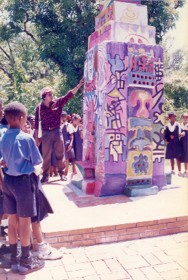The artist behind a monument built in memory of the late Dr Walter Rodney, has expressed concern about the future of the memorial.

Desmond Alli, who has been credited with constructing the National Unity/ Regional Integration Monu-ment, told Stabroek News on Sunday that the authorities have been silent as regards the future of the monument which is situated in close proximity to the facility to house the Central Intelligence Unit of the Joint Services on the lawns of Castellani House.
Efforts to obtain a comment from Culture Minister, Dr Frank Anthony were in vain but this newspaper understands that there is an on-going discussion between the relevant stakeholders as regards the future of the monument with relocation being a possible solution.
Curator of the National Gallery Elfrieda Bissember told Stabroek News that she could not comment on the issue, when contacted yesterday and she referred all queries to the relevant authorities.
Alli, in a letter which appeared in the last Sunday Stabroek said that he made repeated requests for information from the authorities on the issue. He said that, “I don’t want to indulge in idle speculation but the silence on the subject has given rise to all sorts of rumours that the government intends to dismantle the monument”.
Alli said that he was never at any time consulted or informed by the Castellani House Management Committee or the Office of the President of the construction of the intelligence headquarters on the lawns of the National Gallery. He said that he spent several years constructing monuments with the aim of advancing Guyana as the cultural centre of the region.
He told Stabroek News that the initiative was supported by then chairman of the National Gallery, the late Janet Jagan, whom he noted was a generous patron of Guyanese art. Further, permission was granted for the construction of the outlining columns which were to represent regional integration monuments – the National Unity Monument being the centrepiece, he noted.
In correspondence from the National Gallery dated 16th August 2006, Alli was given permission to erect the two additional columns which were to be placed a few feet away to the east and north of the Unity Monument.
Alli said that the monument was built as a consequence of an independent initiative by him, and partly financed from the sale of his work, while businessman Hemraj Kissoon, then Colombian Ambassador to Guyana, Dr Hidalgo May Garcia and the late Gobin Dwarka supported the initiative.
The monument was declared open in mid-1996 to commemorate the 15th anniversary of the assassination of Dr Rodney and among those attending the function were former President Cheddi Jagan as well as resident representatives of several overseas-missions.
Dr Dale A. Bisnauth, then Minister of Education and Culture in declaring open the monument said, “A better day could not have been chosen for the handing over of the monument.
It is a day which commemorates the sacrifice of one of Guyana’s greatest sons’.
Guyana is a country historically and geographically located in the Caribbean and South America, the artist noted and according to him, because of its location, the nation could play a major role in the integration process between the Caribbean and Latin America.
Alli said that the National Unity Monument was built ‘to heal the open wounds of the nation’ and was dedicated to Guyanese of all races, especially in memory of Rodney who he noted, during his short lifetime had made an indelible contribution to improving race relations in Guyana.
He appealed to those concerned to save the National Unity Monument which he noted is the embodiment of the spirit of Rodney and would continue to serve as an inspiration to all who struggle for racial harmony, and for peace and justice.





